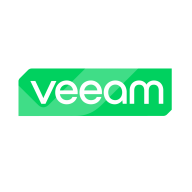


Nutanix Prism and Veeam Data Platform compete in the data management and protection category. Nutanix Prism appears to have an upper hand in seamless data center integration, while Veeam Data Platform excels in robust data protection and recovery.
Features: Nutanix Prism offers a centralized management system that integrates well with data centers, featuring dashboards, performance management, and virtual machine integration. It supports various operating systems, providing seamless virtual environments and disaster recovery without downtime during upgrades. Veeam Data Platform provides reliable backup and replication with fast recovery and comprehensive data protection. Its granularity in restores and application-aware features are beneficial for complex virtual setups.
Room for Improvement: Nutanix Prism could advance its user interface intuitiveness and improve interoperability with platforms like VMware. Its migration tools and licensing model need refinement. Veeam Data Platform requires better integration with physical systems and cloud services. It struggles with large environments where backup processes may not be as efficient. Pricing and licensing complexities need addressing, along with enhanced database integration.
Ease of Deployment and Customer Service: Nutanix Prism is favored for on-premises and hybrid cloud setups, with commendable customer support noted for responsiveness, though documentation can be lacking. Veeam Data Platform is also efficient in these environments, praised for easy setup and strong support, but some users face challenges with licensing and initial deployment complexities.
Pricing and ROI: Nutanix Prism involves higher upfront costs but offers ROI through manpower and energy savings, seen as cost-effective relative to its capabilities. Veeam Data Platform is generally more affordable, with a competitive licensing model, though some users point out price increases and hidden costs. Both provide strong ROI through efficiency, but Nutanix's pricing model is often viewed as more complex than Veeam's.
Initially, the CapEx was higher than VMware's, but considering the operational cost over time, it has been beneficial.
They respond within five minutes and provide excellent assistance.
Nutanix support is excellent, and their response time is extremely fast.
I rate the scalability as ten out of ten.
Integration with other vendors is also seamless.
In order to scale Veeam Data Platform, we have to pay a lot more money.
The entire Nutanix solution is stable.
Even after applying the upgrade, we had to patch again as there was a problem with Prism.
There are no issues with stability in Veeam Data Platform.
The presales and marketing team should inform clients about resource requirements, such as RAM used by CVM, to help manage expectations.
Currently, if I want to use NKP Ultimate or Pro features, I must pay separately, and the process is not easy, especially in Africa.
Reducing it by 20% would make it more accessible to a broader range of customers.
The improvement we would like to see is the option to scale Veeam Data up in smaller sections rather than large sections, which requires paying much more.
The cost is high, and the license payment is not easy in Africa due to numerous intermediaries between users and solution providers.
At first, the cost seemed heavy, but over time, its cost-effectiveness became evident.
A reduction of 20% in the current cost would make the solution more attractive to clients.
From what I know, it is expensive to add modules, with a scale rating of eight out of ten.
It simplifies firmware and software updates, making it hassle-free for IT engineers.
One of the most useful features is the disaster recovery setup, which includes two clusters, one for our production server and another for our recovery site.
The platform is user-friendly, comprehensive, and compatible with numerous market solutions, including virtualization and bare metal servers.
It is also one of the most scalable backup solutions I've worked with.



IBM Turbonomic offers automation, planning, and right-sizing recommendations to streamline resource management, improve efficiencies, and optimize costs across virtualized environments and cloud platforms.
IBM Turbonomic is valued for its capability to optimize resource allocation and monitor virtual environments efficiently. It facilitates automated decision-making in VM sizing, load balancing, and cost optimization for both on-premises and cloud deployments. Users can leverage insights for workload placement, ensure peak performance assurance, and effectively right-size across VMware and Azure. The ongoing transition to HTML5 aims to improve visual and navigational ease, while expanded reporting features are anticipated. Opportunities for improved training, documentation, and integrations enhance platform usability and functionality.
What Are the Key Features?In finance, IBM Turbonomic aids in maintaining platform efficiency during market fluctuations. Healthcare organizations leverage its capability for resource optimization during high-demand periods to enhance patient care support. Retailers use it for planning in peak seasons, ensuring resources align with fluctuating demand to maintain performance continuity.
Nutanix makes infrastructure invisible, elevating IT to focus on the applications and services that power their business. The Nutanix enterprise cloud platform leverages web-scale engineering and consumer-grade design to natively converge compute, virtualization and storage into a resilient, software-defined solution with rich machine intelligence. The result is predictable performance, cloud-like infrastructure consumption, robust security, and seamless application mobility for a broad range of enterprise applications.
Veeam Data Platform ensures comprehensive data resilience by offering secure backups and intelligent data insights, catering to the complexities of modern data management.
Veeam Data Platform empowers businesses with reliable data protection, orchestrated recovery, and streamlined management. Providing peace of mind, it guarantees data is secure, available, and effortlessly recoverable. Organizations benefit from features such as instant recovery, simplified management, and compatibility with virtual environments. While it shines in backup and restore capabilities, it calls for improvements in integration with physical servers and enhanced cyber security features.
What are the key features of Veeam Data Platform?Organizations in industries like finance, healthcare, and manufacturing utilize Veeam Data Platform for critical data management, ensuring business continuity and disaster recovery. Employed in securing both virtual and physical workloads, Veeam integrates cloud storage for enhanced scalability and efficiency.
We monitor all Virtualization Management Tools reviews to prevent fraudulent reviews and keep review quality high. We do not post reviews by company employees or direct competitors. We validate each review for authenticity via cross-reference with LinkedIn, and personal follow-up with the reviewer when necessary.